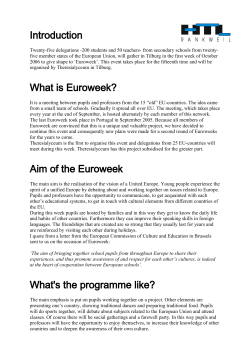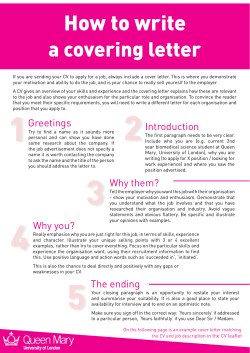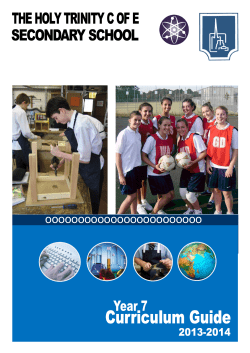
Marham Junior School – E-Safety Policy 1. What is E-Safety?
Marham Junior School – E-Safety Policy 1. What is E-Safety? E-Safety encompasses not only Internet technologies but also electronic communications such as mobile phones, games consoles and wireless technology. It highlights the need to educate children about the benefits, risks and responsibilities of using information technology and provides safeguards and awareness for users to enable them to control their online experiences. 2.1 Writing and reviewing the e-safety policy. The school e-Safety Coordinator is the Senior Designated Professional for Child Protection, as the roles overlap. Our e-Safety Policy has been written by the school, building on the NCC e-Safety Policy and government guidance. It will be agreed by the senior management and approved by governors. The e-Safety Policy and its implementation will be reviewed annually. 2.2 Teaching and Learning. 2.2.1 Why Internet use is important. The internet is an essential element in 21st century life for education, business and social interaction. The school has a duty to provide students with quality internet access as part of their learning experience. Internet use is a part of the statutory curriculum and a necessary tool for staff and pupils. 2.2.2 Internet use will enhance learning. The school Internet access is designed for pupil use and will include filtering appropriate to the needs of the curriculum. Pupils are taught what Internet use is acceptable and what is not and given clear objectives for Internet use. Internet access is planned to enrich and extend learning activities. Staff should guide pupils in on-line activities that will support the learning outcomes planned for the pupils’ age and maturity. Pupils will be educated in the effective use of the Internet in research, including the skills of knowledge location and retrieval. Pupils will only be allowed access to the internet when they are supervised by a member of staff. Marham Junior School 2.2.3 Pupils will be taught how to evaluate Internet content. The schools will endeavour to ensure that the copying and subsequent use of Internet derived materials by staff and pupils complies with copyright law. Pupils should be taught to be critically aware of the materials they read and shown how to validate information before accepting its accuracy. Pupils in year 6 should be taught to acknowledge the source of information used and to respect copyright when using Internet material in their own work. 2.3 Managing Internet Access. 2.3.1 Information System Security The security of the school information systems are reviewed regularly by Headteacher/field technician. Virus and Spyware protection is installed and updated regularly automatically. Login details must not be shared with unauthorised persons. Only equipment approved by the Headteacher may be connected to the school network or systems (including wireless connections). 2.3.2 Email. Users may only use approved e-mail accounts. Users must immediately tell a teacher if they receive offensive e-mail. Users must not send jokes or other materials that the receiver may find offensive Pupils must not reveal personal details of themselves or others in e-mail communication, or arrange to meet anyone without specific permission. The format of a pupil’s school email address should not reveal their gender or location. 2.3.3 Published content and the school website. The contact details on the website should be the school address, e-mail and telephone number. Staff or pupils’ personal information must not be published. A nominated member of staff will take overall editorial responsibility and ensure that content is accurate and appropriate (JM/ZL/MF). The website should comply with the school’s guidelines for publications including respect for intellectual property rights and copyright. E Safety – Draft Policy JM/MF updated 09/01/13 Page 2 of 7 Marham Junior School 2.3.4 Publishing pupils’ images and work. Images that include pupils are selected carefully and do not enable individual pupils to be clearly identified (unless parental permission has been explicitly obtained or these images are already in the public domain). Pupils’ full names will not generally be used anywhere on the website or blog, particularly in association with photographs/video. Website images are reviewed regularly to ensure they remain suitable. 2.3.5 Social networking and personal publishing. Access to social networking sites is blocked/filtered within the school systems. Newsgroups are blocked unless a specific use is approved. Pupils and staff are advised never to give out personal details of any kind which may identify themselves or others and/or their location when online (unless via a secure connection for approved purposes). Examples would include real name, address, mobile or landline phone numbers, school attended, IM and e-mail addresses, full names of friends, specific interests and clubs etc. Users should are advised to place only appropriate photos on any online space. They should consider how public the information is and consider using private areas. Advice should be given regarding background detail in a photograph which could identify the student or his/her location e.g. house number, street name or school. Teachers’ official blogs or wikis should be password protected and run from the school website or within the nsix domain. Teachers must not run social network spaces for student use on a personal basis – However, professional use may be encouraged if specific to a dedicated learning outcome i.e. utilising social networking technology to provide additional support to students with their coursework. If doing so teachers need to ensure that pupils also create a ‘professional’ space for this purpose only All users should be advised on security and encouraged to set passwords, deny access to unknown individuals and instructed how to block unwanted communications. Users should be encouraged to invite known friends only and deny access to others. Users should be advised not to publish specific and detailed private thoughts. Schools should be aware of and deal with bullying that can take place through social networking especially when a space has been setup without a password and others are invited to see the bully’s comments. The inclusion of inappropriate language or images within text or email messages is difficult for staff to detect. Pupils may need reminding that such use is both inappropriate and conflicts with school policy. Abusive messages may be dealt with under the school bullying policy. E Safety – Draft Policy JM/MF updated 09/01/13 Page 3 of 7 Marham Junior School Staff must not communicate with students using public social networking sites such as Facebook, My Space, Twitter, etc. Staff must not communicate with parents regarding any school or pupil-related matters using public social networking sites such as Facebook, My Space, Twitter, etc. 2.3.6 Managing Filtering. The school will work with Norfolk ICT Shared Services to ensure that systems to protect pupils are reviewed and improved. The Headteacher is made aware of filtering profile changes by Norfolk ICT Shared Services. If staff or pupils discover unsuitable sites, the URL must be reported to the e-Safety Coordinator who will inform Norfolk ICT Shared Services. Senior staff will ensure that regular checks are made to ensure that the filtering methods selected are appropriate, effective and reasonable. Any material that the school believes is illegal must be reported to appropriate agencies such as Police, IWF or CEOP and Norfolk ICT Shared Services. 2.3.7 Managing Videoconferencing IP videoconferencing should use the educational broadband network to ensure quality of service and security rather than the Internet. All videoconferencing equipment in the classroom must be switched off when not in use and not set to auto answer. Equipment connected to the educational broadband network should use the national E.164 numbering system and display their H.323 ID name. External IP addresses should not be made available to other sites. Videoconferencing contact information must not be put on the school Website. The equipment must be secure and if necessary locked away when not in use. School videoconferencing equipment must not be taken off school premises without permission. Use over the non-educational network cannot be monitored or controlled. Pupils must ask permission from the supervising teacher before making or answering a videoconference call. Videoconferencing must be supervised appropriately for the pupils’ age. Parents and guardians must agree for their children to take part in videoconferences at least in the annual return. Responsibility for the use of the videoconferencing equipment outside school needs to be established using a risk assessment for the users. E Safety – Draft Policy JM/MF updated 09/01/13 Page 4 of 7 Marham Junior School Only key administrators should be given access to the videoconferencing system, web or other remote control page available on larger systems. Unique log on and password details for access to JANET / UKERNA videoconferencing services should only be issued to members of staff and kept secure (if you are using the National Education Network). Mobile phones may be used as part of lessons or formal school time on occasion for specific purposes. However, the sending of abusive or inappropriate text messages is forbidden and may be illegal. If pupils need to bring a mobile phone or other electronic device into school, these should be named and handed in to the school office on arrival then collected at the end of school Staff must use a school phone or school mobile where contact with pupils or parents is required. If video contact with pupils is necessary staff must use school-owned equipment. 2.3.8 Managing Emerging Technologies. Emerging technologies will be assessed for educational benefit and a risk assessment will be carried out before use in school is allowed. 2.3.9 Protecting personal data. Personal data will be recorded, processed, transferred and made available only in accordance with the Data Protection Act 1998. 2.4 Policy Decisions 2.4.1 Authorising internet access. The school will maintain a current record of all staff and pupils who are granted access to the school’s electronic communications. On admission parents must sign the school e-safety agreement (Appendix A) on behalf of their children. Staff are expected to comply with the professional standards of behaviour outlined in their terms and conditions, school policies and staff handbook. 2.4.2 Assessing risks. The school will take reasonable precautions to prevent access to inappropriate material. However, due to the international scale and linked internet content, it is not possible to guarantee that unsuitable material will never appear on a school computer. The school cannot accept liability for the material accessed or for any consequences of internet access. E Safety – Draft Policy JM/MF updated 09/01/13 Page 5 of 7 Marham Junior School 2.4.3 Handling e-safety complaints. Where necessary the complaints policy and disciplinary procedures will be followed. Parents, teachers and pupils should know how to submit a complaint. 2.4.4 How the internet is used by the school in the community Students with outside access need to follow both the school’s E-policy and any applicable to the placement. The school will be sensitive to Internet related issues experienced by pupils out of school, e.g. social networking sites, and offer appropriate advice. 2.4.5 How the Internet is used by the community in the school Community users coming into schools must adhere to the school’s E-safety policy. 2.5 Communications Policy If pupils need to bring a mobile phone or other device into school for use after school, these should be named and handed in to the school office upon arrival and collected at the end of school 2.5.1 Introducing the e-safety policy to pupils. E-Safety rules will be posted in rooms with Internet access. Users will be informed that network and Internet use will be monitored. The Headteacher must ensure that an appropriate person attends an e-safety training programme to raise the awareness and importance of safe and responsible internet use. Instruction in responsible and safe use should precede Internet access. 2.5.2 Introducing the e-safety policy to staff All staff have access to the School e-Safety Policy. Staff should be aware that Internet traffic can be monitored and traced to the individual user. Discretion and professional conduct is essential. Staff training in safe and responsible Internet use and on the school e-Safety Policy will be provided as required. 2.5.3 Enlisting parent’s support. Parents’ attention is drawn to the school’s e-Safety Policy on admission in the school brochure and on the school website. Internet issues will be handled sensitively, and parents will be advised accordingly. A partnership approach with parents will be encouraged. This may include parent evenings with demonstrations and suggestions for safe use. E Safety – Draft Policy JM/MF updated 09/01/13 Page 6 of 7
© Copyright 2025












